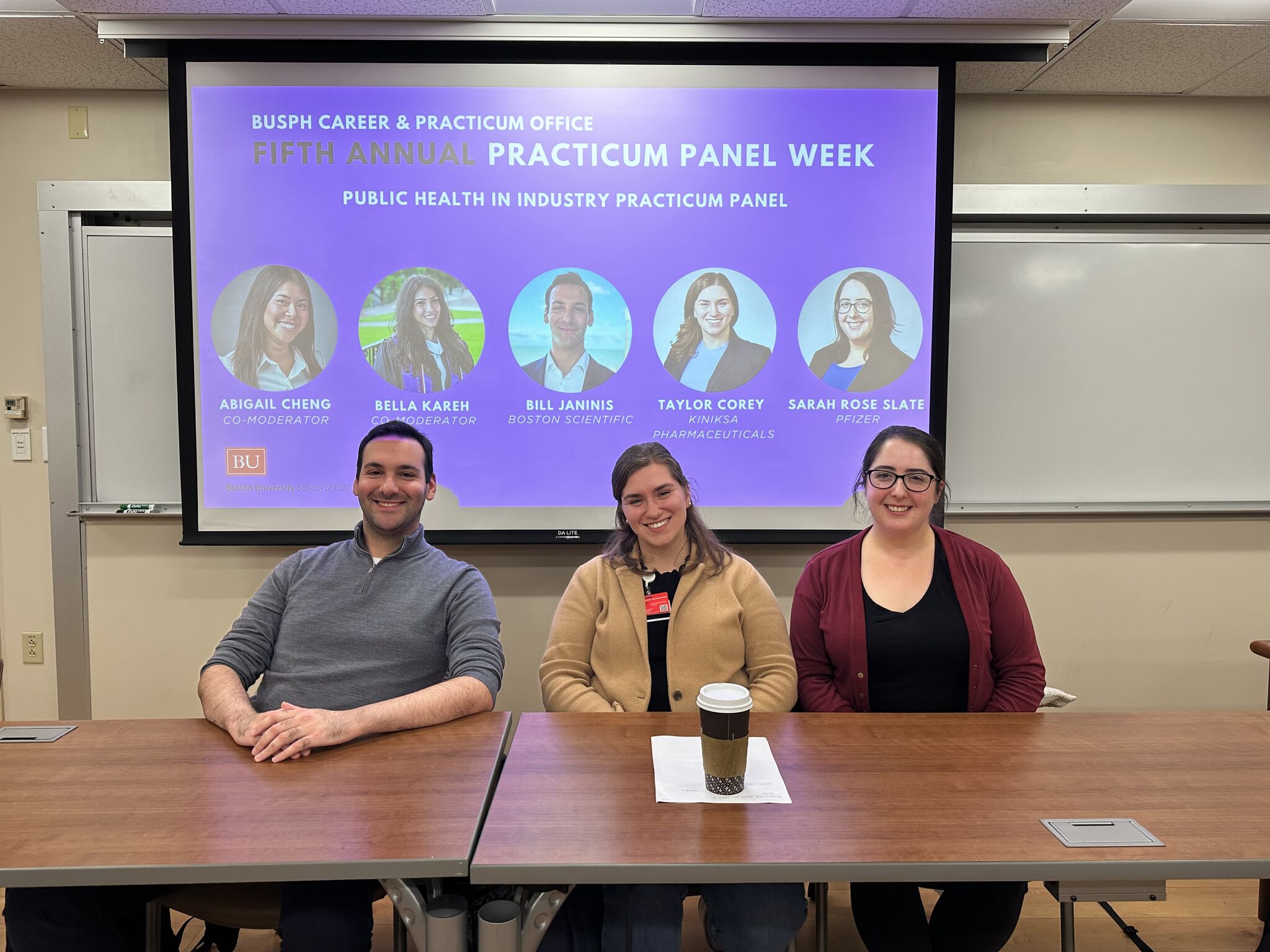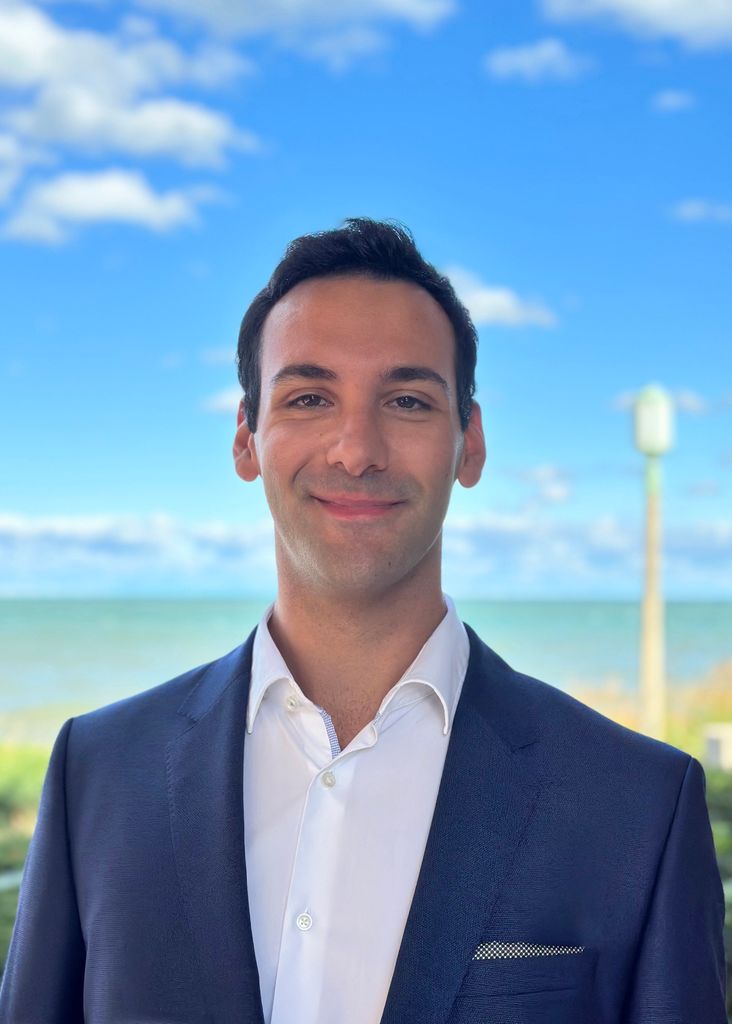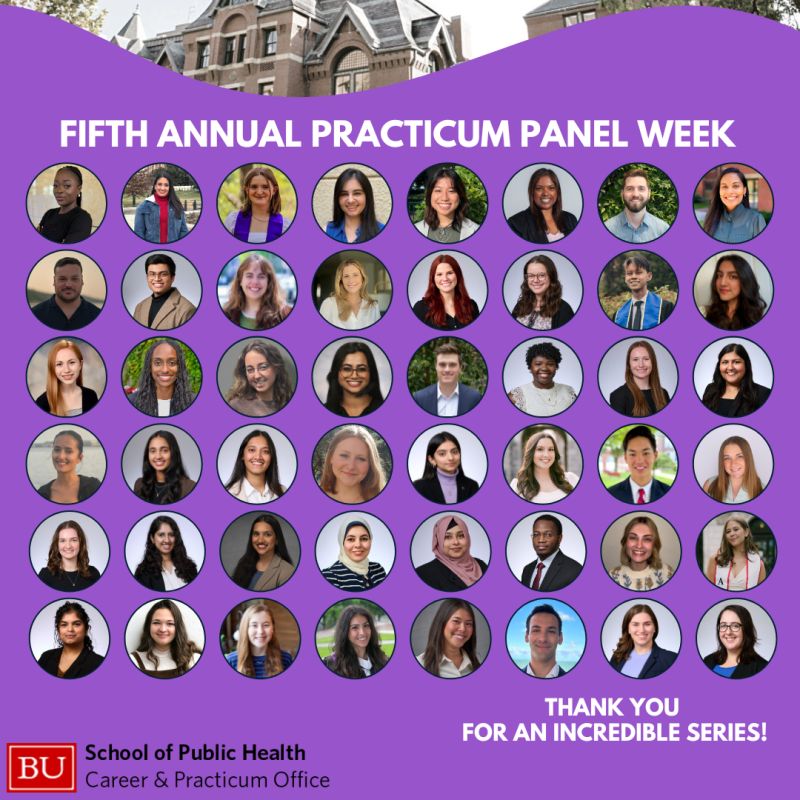Practicum Panelist Tells All.

A panel on practicums in industry during the School of Public Health’s fifth annual practicum week. The panelists and their practicum organizations, from left: Bill Janinis, Boston Scientific; Taylor Corey, Kiniksa Pharmaceuticals; and Sarah Rose Slate, Pfizer. Photo courtesy of Bill Janinis.
Practicum Panelist Tells All
Bill Janinis, an on-campus MPH student who completed a practicum with Boston Scientific in summer 2025, recently spoke on a panel where SPH students and alumni shared their practicum experiences with peers beginning to search for opportunities of their own.

More than 175 on-campus MPH students participated in the School of Public Health’s 2025 Practicum Panel Week, a series of conversations where alumni and second-year students share their practicum experiences with first-year students about to embark on their own practicum journeys. Held in-person and online from October 27 to November 4, and hosted by the Career & Practicum Office, the panels marked the School’s fifth annual Practicum Panel Week.
Among the nearly 50 alumni and second-year students who served as panelists and moderators was Bill Janinis, a second-year, on-campus MPH student pursuing certificates in biostatistics and epidemiology, and pharmaceutical development, delivery, and access. Janinis completed a Bachelor of Science in healthcare administration at Loyola University Chicago and worked as a business systems analyst at a mental health and wellness platform before matriculating into the MPH program at SPH in August 2024.
“It was especially meaningful to sit on the panel alongside two other rockstar classmates, a great reminder of the strength and talent within our BUSPH community,” wrote Janinis in a LinkedIn post thanking Ryan Wisniewski, assistant director for SPH’s practicum program, for organizing the event.
This year, Wisniewski expanded practicum week, adding two new panels: a panel on public health in industry and another focused on environmental health, urban health, and climate. The 2025 series featured the perspectives of alums who are now practicum supervisors themselves, a panel dedicated to finding a practicum as an international student, and panels focused on different subject areas of public health, such as community-based work, governmental public health, policy and advocacy, healthcare management, research and data, and global, immigrant and refugee health.

As a member of the new panel focused on the pharmaceutical and biotechnology industries, Janinis spoke about his summer practicum experience as a health economics and outcomes research intern at Boston Scientific, a global medical technology company.
“It’s been a great journey so far. When I came [to SPH], I had a very singular goal of getting a career in the life science industry, and I knew I was going to get world-class quantitative training that would allow me to do that, especially with the pharmaceutical certificate,” says Janinis. “I’ve taken really interesting classes, not only my quantitative coursework, like coding or epidemiology methods, but I was also able to take more applied evaluation classes, like the Essentials of Economics and Finance for Global Health class I’m in right now. We do a lot of economic modeling and sensitivity analysis, which was used a lot at my internship too.”
After graduation, Janinis hopes to work as a health economics and outcomes research analyst, real-world evidence analyst, or market access analyst. He enrolled in the economic evaluations course (GH762) on the recommendation of his Applications of Intermediate Epidemiology (EP850) course instructor, Emily Goldmann, a clinical associate professor in the Department of Epidemiology. She suggested he complement his scientific training with knowledge of the industry’s commercial side.
Janinis shares more details of his experience with the broader SPH community in the following Q&A.
Q&A
With Bill Janinis, an on-campus MPH student and former intern at Boston Scientific
SPH: How did you find your practicum at Boston Scientific, and what were the responsibilities of your role there?
Bill Janinis: It was a bit of a wild ride finding a practicum, especially because I was looking for these specialized kinds of roles in the pharma realm. What happened with the Boston Scientific practicum was that I was at the career fair at BU, and I saw that they were going to offer health economic internships, so I just went up to them and started conversing with them, asking them about a few things. The person that I talked to the most and clicked with the most happened to be my future manager, Alicia.
I was working in the peripheral interventions division, running economic evaluations on different medical devices. One of my big projects was a cost analysis of a medical device and its competitors. I ended up doing literature reviews—that was a big part of my day-to-day work. Then, I ended up doing a lot of programming and coding in Stata. I was working with claims data, which is real-world data since the device had already entered the market. It was past phase three of the clinical trials, so most of the data was observational. I analyzed that, came up with basic descriptive statistics, and then I also ran multivariable linear regression models to adjust for various covariates. We ran some cost analysis, too. It was really nice—actually, I will end up with one or two publications out of that.
We were also highly encouraged to network within the broader organization. We had a list of people that we should contact based on our preferred fields, or what we want to do, or what we want to learn. Every week, I would schedule around three to five different calls with people. These could be other analysts, managers, directors, or even the senior vice president of health economics. This helped a lot, especially when it comes to credibility within the life science industry. It carries a lot of weight because, in these fields, everyone knows each other. This is what I gathered. So, the more people you know and the more credible you are, the better it is for your long-term career prospects.
SPH: Is there anyone at Boston Scientific with whom you keep in touch or consider a mentor?
Bill Janinis: Yes, I have my manager, who is a health economist there, and then I have the director for health economics, Bola, [whom] I also check in with. I probably check in with her once a quarter. The vice president too, Liesl, was amazing. She really loved mentoring people. Again, a thing that stood out at Boston Scientific was how collaborative the culture was, and how encouraging it was in terms of not only promoting growth but also being super inclusive. They really helped you. They really wanted you to succeed, and they gave you all the resources you needed and support.
Boston Scientific heavily invested in us. We got the opportunity to attend some expensive seminars on data visualization. They [paid] for interns to be there, and we ended up gaining extra certifications through that process. It was some basic stuff like “dashboarding” in Excel and PowerPoint. It was [about] how to make things more easily digestible for different audiences, specifically non-technical audiences, because HEOR, pharmacoepidemiology, epi, and all [those areas], they’re very technically heavy, and a lot of the time, when you have a certain position in that industry, you have to talk to a lot of non-technical stakeholders. [The seminars] showed you how to take big, complicated pieces of information, and make them more readable and more understandable [for] non-technical stakeholders.
SPH: What are you most proud of having accomplished during your practicum?
Bill Janinis: I ended up learning Stata from scratch. I had only taken R and SAS, [but] my training really helped me accelerate my learning curve when it came to Stata. We were also encouraged to use a lot of artificial indulgence, too. Boston Scientific had its own ChatGPT enterprise account, and we were explicitly [encouraged] to use it by our managers. So, I used that a lot for my literature reviews, to basically synthesize a lot of findings from different articles. Then, [I did] code checks for Stata. For example, if I ran code for some basic descriptive stats or a regression model, I would also throw it into ChatGPT, and [ask], “Hey, is this correct?” or “How can I make this better?” or “How can I also run a macro for a certain function so I can make it easier to streamline doing the same thing again and again?”
SPH: You mentioned surviving a fairly arduous application process—do you have any advice for students who are just beginning the practicum search?
Bill Janinis: A few words of wisdom: number one would be just don’t give up. It’s a numbers game. Apply, apply, apply. Number two: network. If there’s a company that you like or a position that you like, I would highly encourage you to […] find people either from BU or this specific program that have gone into these industry positions, or people on LinkedIn doing the same thing. Don’t be afraid to get ghosted. Don’t be afraid to just reach out, schedule coffee chats, get to understand what these people are doing and the training that’s required. Number [three], keep practicing the interview skills. And another thing is to leverage the career and practicum office at SPH. Marie Daniel was my absolute lifesaver. She helped me so much. I ended up getting a second [practicum] offer because of her. She ended up reaching out to her own network because I took the time to build a connection with her and build a relationship with her.
